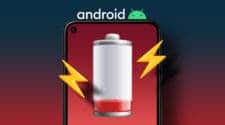Google often releases an ‘a’ model sometime after the regular flagship duo, and that’s the case with the Pixel 8a. If you already have the Pixel 8, there’s not much to consider. But if you’re shopping for a new Pixel, it can be more complicated. So, we’ve put together a summary of how the Pixel 8a is similar to the Pixel 8 and how they differ. This might help you decide which one is right for you.
Dimension Comparison
You might think the Pixel 8a is more compact than the Pixel 8 because its display is 0.1 inches smaller. However, the large black bezel around the Pixel 8a’s screen actually makes it the bigger device. The extra 1.6mm in height is hardly noticeable, but the nearly 2mm in additional width is more apparent. Despite this, the Pixel 8a is still one of the more compact smartphones available in 2024. The Pixel 8 is slightly smaller and will save you a bit of pocket space. Both phones weigh about the same, so weight isn’t a factor to consider.
From the back, the two phones look very similar, but the similarity is only superficial. The Pixel 8 has a Gorilla Glass Victus panel, while the Pixel 8a has a plastic back. The 8a has a frosted finish, similar to the Pixel 8 Pro, while the Pixel 8 has a glossy finish.
On the front, the Pixel 8 features another sheet of Gorilla Glass Victus, while the Pixel 8a uses Gorilla Glass 3. While Gorilla Glass 3 isn’t the latest in shatter resistance, it should still provide adequate protection against scratches. Both handsets have an aluminum frame with a satin sheen finish, so there’s no difference in that aThe Pixel 8 has an advantage in maximum brightness when adjusting the slider manually, reaching up to 1001 nits. The Pixel 8a isn’t far behind with 755 nits. In adaptive brightness mode, both phones get a boost to about the same level, with the 8a having a slight edge at 1508 nits compared to the Pixel 8’s 1446 nits.spect.
Both phones have for dust and water resistance rating and should survive a dunk in a clean puddle. However, the Pixel 8 has a higher IP68 rating (30 minutes in 1.5 meters of water), while the Pixel 8a has an IP67 rating (30 minutes in 1.0 meter of water). The difference is minor.
Display Differences
Both displays are quite similar, though the 8a’s is slightly smaller at 6.1 inches compared to the 8’s 6.2 inches. Both have a 1080p resolution and a maximum refresh rate of 120Hz, with basic adaptive behavior that reduces to 60Hz when idle. They both support HDR10 and HDR10+, but not Dolby Vision. The main difference is in the bezels: the black strip around the Pixel 8’s display is quite slimmer, giving it a more modern look.
The Pixel 8 has an advantage in maximum brightness when adjusting the slider manually, reaching up to 1001 nits. The Pixel 8a isn’t far behind with 755 nits. In adaptive brightness mode, both phones get a boost to about the same level, with the 8a having a slight edge at 1508 nits compared to the Pixel 8’s 1446 nits.
Battery Comparison
The Pixel 8a has a slightly smaller battery than the Pixel 8 (4,492mAh vs. 4,575mAh) and a slightly smaller display (6.1″ vs. 6.2″). Since both phones use the same chipset, they deliver similar endurance in testing. Therefore, battery life won’t be a deciding factor between the two.
Charming Speed Comparison 
It’s no more surprising that Pixels have never been leaders in charging speed, and this is true for the Pixel 8 as well. However, the ‘a’ series is notably worse. The Pixel 8a maxes out at 18W, compared to the Pixel 8’s 27W capability. In practice, the Pixel 8a will be significantly slower than the Pixel 8 both in the initial stages of charging and in reaching 100%.
The Pixel 8a and 8 both support wireless charging. However, the Pixel 8a is rated for up to 7.5W, whereas the Pixel 8 lists 18W in its specifications. Nonetheless, the Pixel 8’s maximum rating of 18W is only achievable with the proprietary Pixel Stand (2nd gen); generic Qi pads typically charge at up to 12W.
When it comes to wireless charging, speed may not be a critical factor if you’re not in a rush. The important thing is that the Pixel 8a includes the feature, despite its slower charging rate compared to the Pixel 8. It is worth noting that the Pixel 8a does not support reverse wireless charging, so if that feature is important to you, the Pixel 8 would be the better choice.
Speaker Comparison
Both Pixel phones use the same speaker setup, with one bottom-firing unit and another serving as both a top speaker and earpiece. In testing, the Pixel 8a received a ‘Good’ rating for loudness, while the Pixel 8 earned a ‘Very Good’ rating, though the difference is minimal. The Pixel 8a already offers pretty great sound quality, but the Pixel 8 enhances this with richer treble.
Comparing Performance
Both the Pixel 8a and Pixel 8 are powered by Google’s Tensor G3 chip, equipped with 8GB of LPDDR4X memory, and offer either 128GB or 256GB of UFS 3.1 storage. For those needing more than 8GB of RAM or higher storage capacities, the Pixel 8 Pro is the option to consider.
The Pixel 8a comes with Android 14 out of the box. Like other recent Pixel models, it’s promised to receive 7 years of software updates from its release date. Both devices should be on par in terms of software longevity.
The prime core of the Tensor G3 chip delivers excellent performance, but overall multi-core CPU performance is mid-range. The GPU is also upper-tier mid-range, which is respectable but doesn’t match current Snapdragon standards. These characteristics apply equally to both the Pixel 8a and Pixel 8, so performance alone won’t be the deciding factor between the two.
Comparing Camera Performance 
One significant difference between the Pixel 8a and Pixel 8 lies in the camera department. The Pixel 8a lacks some key features compared to its counterpart. In fact, all three camera modules on the Pixel 8a are carried over from the 7a, while the Pixel 8 uses superior hardware.
Notably, the Pixel 8a’s ultrawide camera lacks autofocus (AF), which means it cannot achieve close-up ‘macro’ shots. Additionally, the main camera on the Pixel 8a lacks a laser autofocus (AF) sensor, which the Pixel 8 does include.
In terms of camera specifications, the Pixel 8a and Pixel 8 show some differences:
1. Main Camera: The Pixel 8a’s main camera has a smaller sensor size (1/1.73″) compared to the Pixel 8 (1/1.31″), but it offers higher resolution (64MP vs. 50MP). This results in 16MP photos from the Pixel 8a versus 12.5MP photos from the Pixel 8.
2. Ultrawide Camera: The Pixel 8a’s ultrawide camera is 13MP but outputs 16MP photos to match the main camera’s resolution. In contrast, the Pixel 8 sticks to 12.5MP for ultrawide shots.
3. Front Camera: The Pixel 8a features a 13MP selfie camera, while the Pixel 8 has a 10.5MP selfie camera. Neither phone has autofocus (AF) for selfies, a feature reserved for the Pixel 8 Pro.
Despite these differences in resolution and sensor size, both the Pixel 8a and Pixel 8 offer the latest camera features from Google, so there’s no differentiation in terms of features.
Camera Image Comparison
It’s noted that the photos and videos on this page were taken at different times with the two phones, as the Pixel 8 is no longer available for side-by-side comparisons. However, major differences in global parameters are not expected, as Google aims to deliver a consistent look across all its models, similar to Apple. Thus, comparisons across different seasons are still acceptable.
Both phones capture excellent images in daylight with their main cameras, featuring reliable white balance, vibrant colors, high contrast, and good dynamic range, with minimal noise. Based on our experience, photos from the Pixel 8 tend to be slightly sharper at the pixel level.


This impression is reinforced at 2x zoom, where the Pixel 8 maintains a slight edge. The ultrawide cameras on both phones deliver similar detail at the pixel level. However, we find the Pixel 8a’s image processing to be slightly more pleasing to the eye.


Low Light
In low-light conditions, the Pixel 8a occasionally shows a minor advantage in sharpness and detail in its main camera images. While our preference for the underdog might be affecting our judgment, it’s clear that you won’t be sacrificing low-light image quality with the main camera of the Pixel 8a compared to the Pixel 8.


At 2x zoom, the midrange pixel performs just as well as the more expensive flagship competitor. There’s no significant advantage to choosing one over the other in this regard. Regarding the ultrawide cameras, we can confidently say that the Pixel 8a performs better than the Pixel 8 in low-light conditions. The difference isn’t dramatic, but the Pixel 8a does have a slight edge. Regarding selfies, the Pixel 8a performs admirably, but the Pixel 8 has a slight edge in sharpness.
Video Comparison
The video quality from the main cameras of both phones is essentially the same, whether at their native zoom levels or at 2x. However, when it comes to ultrawide videos, the Pixel 8a has a slight edge.
In low-light conditions, neither ultrawide camera produces particularly pleasing videos, but the clips from the Pixel 8 are slightly softer. On the other hand, main camera footage from the Pixel 8 appears marginally sharper.
Conclusion
The Pixel 8a’s launch price might initially place it close to the current prices of a “true” Pixel 8. However, both phones may receive discounts from time to time, especially during sales events. We anticipate that the Pixel 8a will eventually become a significantly more affordable option in Google’s lineup. It’s positioned as a straightforward choice for those seeking the latest Pixel experience, offering all the essential Pixel features like great camera performance and software updates without any unnecessary frills.
Certainly, the Pixel 8 holds an edge in several areas and offers additional features that may appeal to users. Charging speed is a notable difference where the Pixel 8 excels, which could be a deciding factor for many. Moreover, it also supports reverse wireless charging, allowing it to charge other devices from its back, a feature absent on the 8a.
In terms of build quality, the Pixel 8 also stands out with its nicer build materials. It boasts an IP68 rating for water and dust resistance, superior to the IP67 on the Pixel 8a, and uses Gorilla Glass Victus compared to Gorilla Glass 3. The slimmer bezels on the Pixel 8 contribute to a more modern look compared to the somewhat chunkier design of the 8a.
Camera performance is another area where the Pixel 8 shows its strengths, especially with better selfies, rear camera portraits, and the versatility of its autofocus (AF) capable ultrawide camera. However, the Pixel 8a still performs admirably across its camera setup and delivers a solid overall experience.





